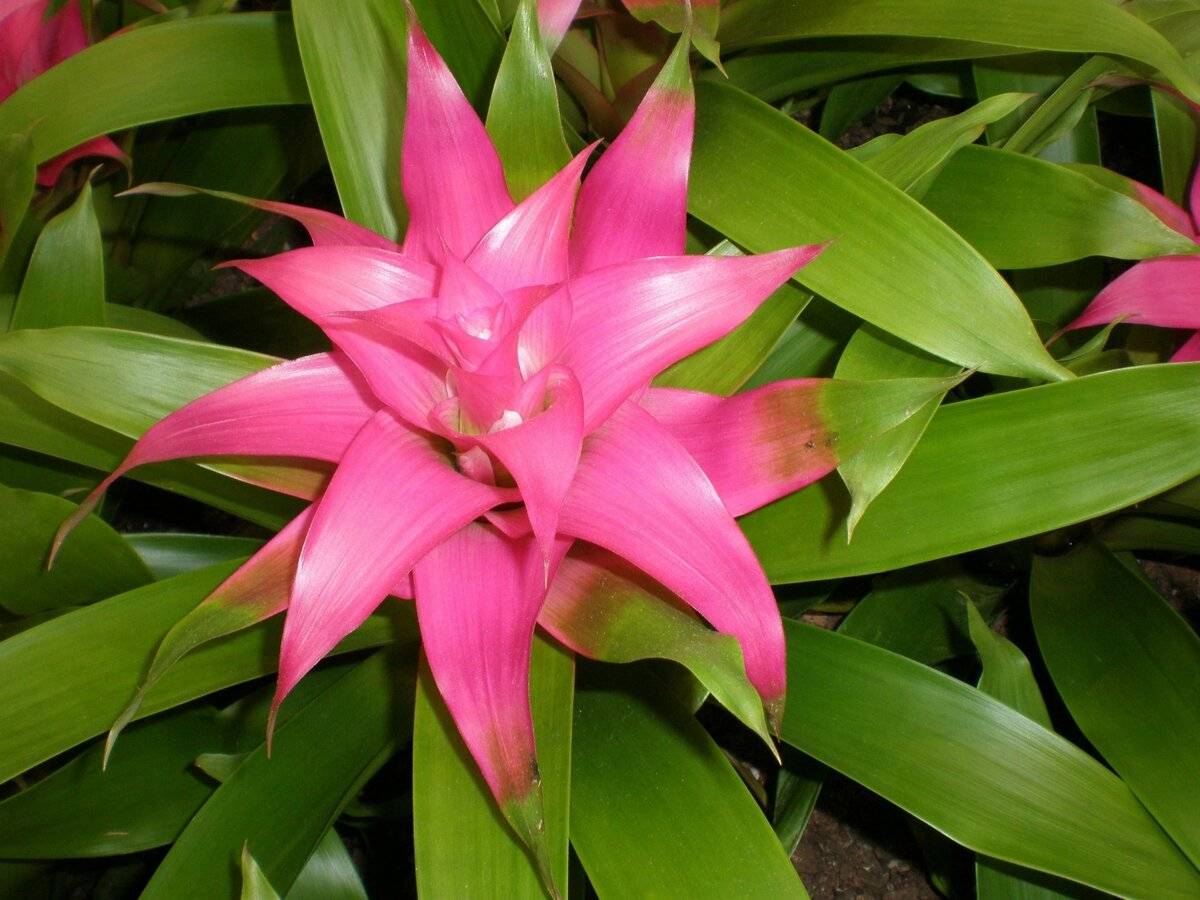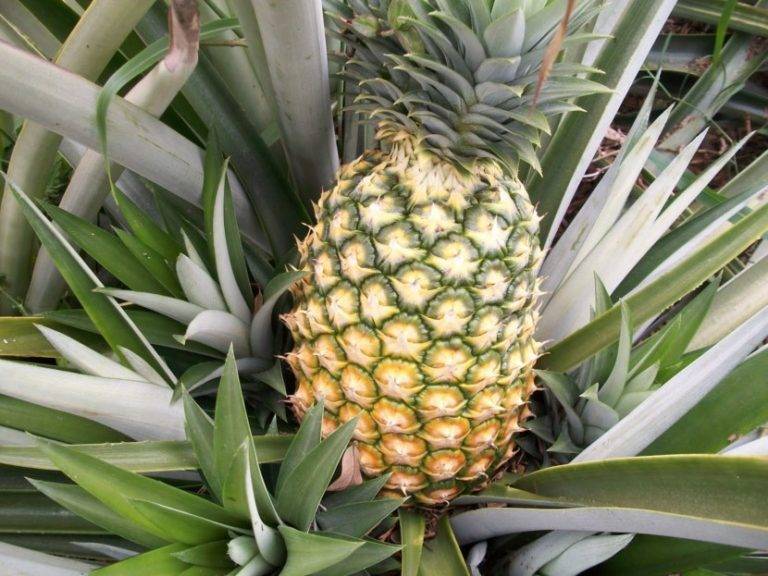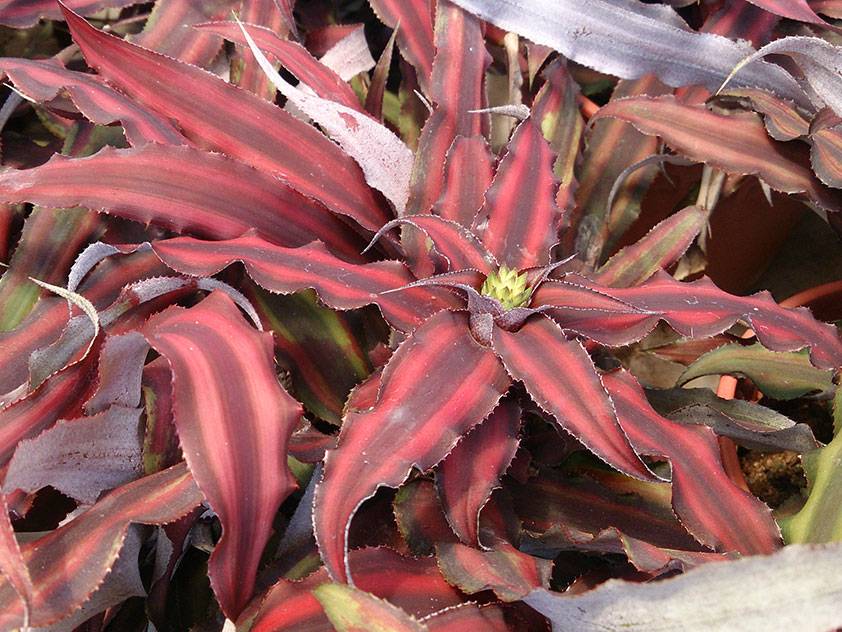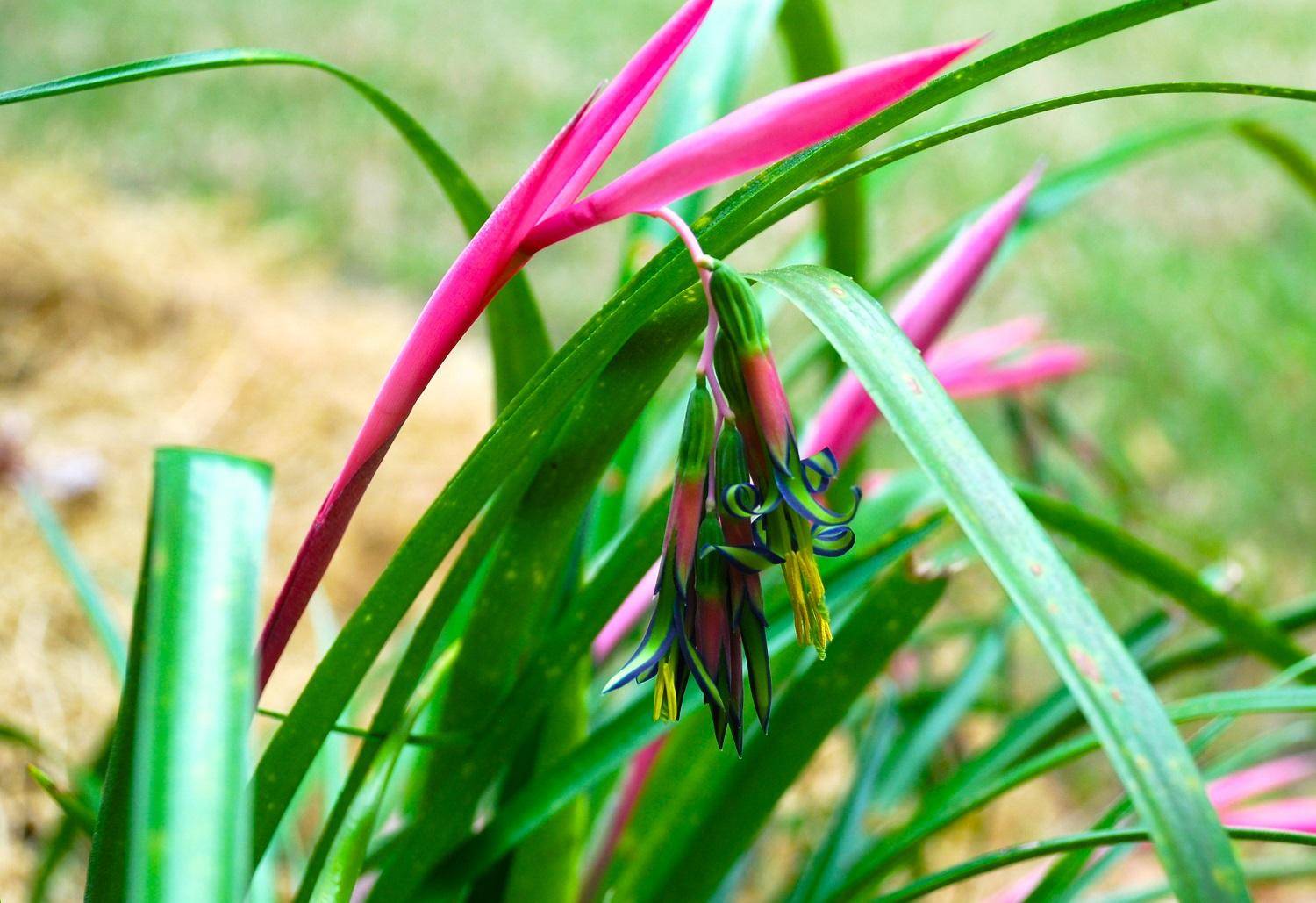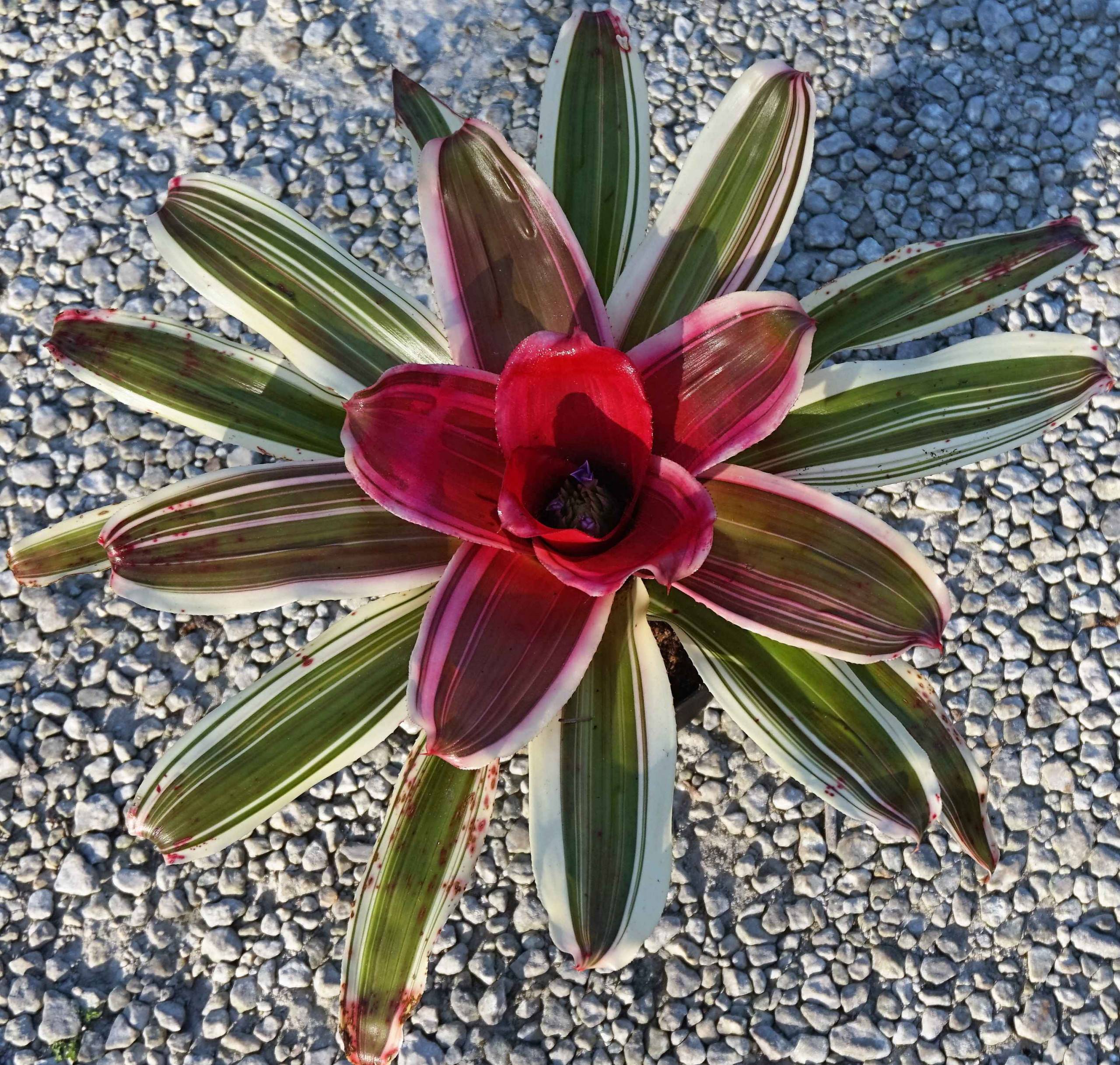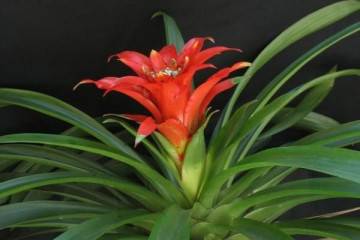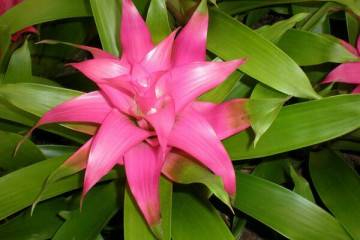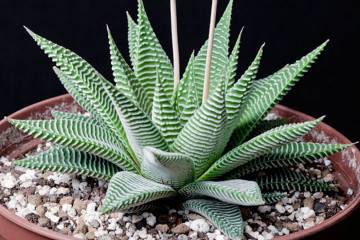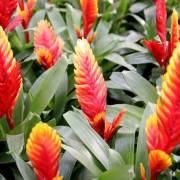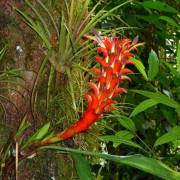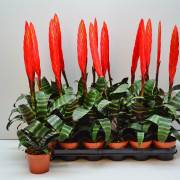Bromeliad family - tillandsia, pineapple, bromeliad and others
Content:
- Bromeliad family
- How to care for these plants at home
- Tillandsia is a plant without roots
- Pineapple as a house pot plant
- Guzmania (guzmania): description of the plant and flower
- Cryptantus: home care
- Bilbergia drooping
- Ehmeya flower: home care
- Bromelia de Zapata is a bright representative of the family
- Vriezia Astrid: description of the plant and features of care
- Neoregelia: home care
Every day the world becomes more and more open, horizons expand. Amateur gardeners are also taking advantage of this situation. Exotic cultures are preferred. These include representatives of the Bromeliads family (botanical name Bromelia). These are perhaps the brightest exotic species available for indoor breeding.
Bromeliad family
The Bromeliad family includes three subfamilies. It:
- Pitcairnias (Pitcairnioideae);
- tillandsia (Tillandsioideae);
- bromeliads (Bromelioideae), or pineapple.
Houseplants from the Bromeliad family: types and features
According to the description, bromeliads have a close relationship with the familiar pineapple, which is quite an edible fruit. And this is no accident, since they are relatives.
All types of culture are of floristic interest. But of them cryptanthus, guzmania, vriezia, indoor pineapple, ehmeya, neoregelia, bilbergia, acanthostachis, neoregelia, nidularium are most in demand.
Common features of all varieties and types:
- seasonal flowering, that is, in summer;
- the inflorescence is a modified, apical leaf rosette;
- the ability to bloom only once. The flower stalk dies, leaving behind a bunch of children.
For breeding, babies (kiki) and seeds are used. The first method is used more often.
General information about the Bromeliad family
In the Bromeliad family there are plants and epiphytes growing on the ground. The latter grow by clinging to nearby objects (trees, bushes, stones, buildings, etc.). However, they are not parasites. Food is obtained from air (moisture droplets) and sunlight.
The leaves of the culture are dense, glossy. As they develop, they form a funnel-shaped rosette. The top of the flower changes over time (due to the bracts). An inflorescence (racemose, capitate, paniculate or spike-shaped) grows from it. The color of the brushes is very bright - all shades of red and yellow.
The flowering period depends on the species and can last from 2-3 weeks to 2-3 months.
How to care for these plants at home
Home flower care consists of:
- top dressing. During the growing season, fertilization is required 2 times a month. Complex fertilizers are suitable for indoor flowers. In winter, it is enough once every 1.5 months;
- glaze. Given the growth in the tropics, the plant needs to be moistened regularly;
- trimming. This applies to a faded peduncle;
- transplants. Only when needed. If the pot is too small.
Temperature, humidity, light
Exot needs a long day of light at least 12 hours a day. Required temperature regime: summer time - 20-25 ° С, during the rest period - 15-18 ° С. The optimum humidity is 70%. Watering is carried out through the pallet and regular spraying.
Optimal soil for Bromeliads
The main requirement for the soil is looseness and lightness. Soil for Bromeliads can be purchased at the store, or you can prepare it yourself.
A good substrate will come from:
- leaf land - 2 parts;
- humus and peat - 1 part each;
- river sand - 0.5 parts.
Tillandsia is a plant without roots
Tillandsia is a plant without roots. They are needed exclusively for attaching to neighboring objects.
The plant gets its nutrition from moist air. It enters through the trichomes (hair scales) that cover the leaf plates.
Features of caring for atmospheric bromeliads
It is impossible to grow an epiphyte without effort. It is necessary to create a special microclimate for it - a constant humidity of at least 75%. They do not need a pot with soil, but the roots of the flower must have strong support. It can be stones, tree-like house flowers (only moisture-loving).
Transplant of atmospheric tillandsia
The transplant itself is not about tillandsia without roots. Unless you need to replace the support, for example, a transport bark for a stone.
Variety of types of atmospheric tillandsia
There are many types of air tillandsia, but the most popular of them are:
- usneiform;
- Tillandsia Gardener;
- tillandsia Bulboza;
- tillandsia silvery;
- tillandsia jellyfish head;
- tillandsia sitnikovaya;
- tillandsia violet-flowered;
- protruding tillandsia;
- tricolor tillandsia;
- tillandsia Louisiana moss.
Pineapple as a house pot plant
Homemade pineapple (Bromelia Ananas) is an edible cultivar. From the 17th century. grown in conservatories for this very purpose.
For indoor growing, two types are in demand:
- crested pineapple (Ananas comosus);
- bracts pineapple (Ananas bracteatus).
The fruit is quite large, 30 cm. Full ripening occurs within six months. Ripe pineapple has yellow peel, light yellow flesh. It tastes sweet with sourness.
Taking care of indoor pineapple is easy. To obtain fruit, it is required to transplant every two years into a larger pot.
Temperature, humidity and illumination
For exotics, the permissible temperature regime is from 16–17 ° С to 25 ° С. Pineapple at home in a pot should be placed in a well-lit area. Daylight hours should be at least 8 hours a day. Permissible humidity from 65%.
Watering mode
During the growing season, watering is required abundant, but after the topsoil has completely dried out. In winter, it should be very rare, no more than once a month. Water for irrigation is taken warm and settled. It is advisable to spray regularly, especially in the heat, as pineapples are grown in warm, humid climates.
Soil and fertilizers
Pineapple grows well in acidic loose soil. A mixture of:
- humus - 2 parts;
- turf - 3 parts;
- river sand - 1 part;
- peat - 3 parts.
Any fertilizer is suitable for flowering plants.
Guzmania (guzmania): description of the plant and flower
What is Guzmania? Bromelia Guzmania is an epiphytic flower.Like other relatives, root nutrition is obtained from the air. The main differences from them:
- colorful bracts. They are red, orange, yellow, purple;
- a characteristic feature - after flowering, the plant dies.
Description of popular types of guzmania, adapted for indoor breeding
For home content, they try to choose compact varieties of guzmania. The most demanded ones:
- reed guzmania is a large flower with half-meter leaves. The rosette of the plant is dense. Peduncle red or orange, small white flowers;
- Minor is a hybrid of reed Guzmania. The plant is compact, blooms from late winter to early autumn. Its bracts are red, flowers are white and few;
- hybrid Tempo. It differs from Minor only in size, it is larger;
- hybrids Mix. A lot of them. They differ in the colors of the panicles;
- Guzmania Nicaraguan. Compact version. The rosette consists of long, densely folded leaves. Spike inflorescence is light red. The flowers are bright yellow;
- Guzmania Konifer. Large-sized flower with a high red-yellow inflorescence;
- Donell-Smith's guzmania. The inflorescence is dense, paniculate. The flowers are bright yellow. Sepals are bright red;
- one-headed. Very decorative rosette. Its long leaves from bottom to top change their shade from light green to green-yellow. The peduncle also changes color from green to red (scarlet, orange). The flowers themselves are white;
- Ostara is a hybrid of Reed Guzmania and Guzmania Witmackii. Long blooming epiphyte with burgundy bracts;
- Tricolor. It is distinguished by the beauty of the striped leaves. There are clear red and white stripes on a green background. Flowers are yellowish, inconspicuous.
Care features
Guzmania prefers temperatures between 18 ° C and 25 ° C and lacy shade.
Watering is carried out as the soil dries up. Warm water is needed. Spraying is encouraged. Desired air humidity 60-85%.
The soil is loose, lightweight. A mixture for orchids will be optimal. A third of the pot's volume should be filled with drainage material. A ceramic shallow pot will do.
Does not need constant feeding.
Cryptantus: home care
Caring for cryptantus at home is no different from caring for other bromeliads. For them, the main thing is warmth and humidity. Grows well inside glass vases.
Description of the flower
The main difference is the variety of leaf colors. They are white, pink, burgundy, yellow. This species does not have a peduncle. The apical leaves form an asterisk.
Requirements for humidity and temperature
The optimum temperature of the content is 18-25 ° C, the humidity is from 70%.
Bilbergia drooping
Bilbergia drooping is one of the few varieties that is undemanding to lighting.
Plant care consists of regular watering, spraying and feeding.
Temperature, humidity and illumination
The species tolerates temperatures of 12 ° C well at any time of the year. Grows well on the northern windowsill. Daily spraying will be sufficient to maintain the desired moisture content.
Watering mode
The next watering is recommended after the soil dries up by 1.5-3 cm. The water should be warm and settled.
Soil and fertilizers
Top dressing should be complete throughout the year: in the summer every 2 weeks, in the winter once a month. The soil is suitable for sour (pH = 5), rough.
Ehmeya flower: home care
Echmea striped (Aechmea fasciata) is a fairly popular variety.
Conditions for growing at home
This is a convenient flower for home growing. Prefers sunny windowsills. To maintain humidity, it is recommended to use a pallet with damp expanded clay.
Temperature, humidity and illumination
The plant needs good lighting. Avoid direct sunlight.
The optimum temperature is from 15 ° C to 26 ° C, air humidity is 70-75%.
Watering mode
Watering is required abundant, preventing the soil from drying out, while it is better to pour water into a funnel of leaves.
Soil and fertilizers
A soil mixture of sand, leaf turf, peat in a ratio of 1: 2: 1 will be suitable.
You need to feed the flower twice a month with a complex composition for Bromeliads.
Bromelia de Zapata is a bright representative of the family
From other varieties of bromeliad de Zapata differs only in the shape of the flowers. They resemble shoes on a stalk.
What the care consists of: watering, feeding, spraying.
Temperature, humidity and illumination
It grows well at temperatures from 15 ° C to 25 ° C, humidity about 65%. You need diffused light or partial shade.
Watering mode
Watering is needed after the topsoil is completely dry. Regular spraying is encouraged.
Soil and fertilizers
Fertilizers are suitable for flowering plants. The soil is needed loose, rough, sour.
Vriezia Astrid: description of the plant and features of care
Vriezia Astrid (Bromelia Vriesea) has about 100 varieties. They are all tall. Depending on the variety, the color of the leaves can be different (green, striped, purple, crimson).
Vriezia brilliant
Vriesea brilliant, or royal (Vriesea regina) - a variety that is distinguished by shiny long leaves. With a peduncle height of 2 m, the leaves grow up to 1 m and longer. Paniculate inflorescence with light yellow fragrant flowers. Bracts are pink.
Vriezia Slendens
Vriesia Splenriet is the most beautiful representative of the Bromeliads. A funnel-shaped rosette of leaves grows to almost 0.8 m. The leaf blade itself can be cross-striped. Its edges are bent. The peduncle is long, the inflorescence is spike-shaped, large, bright red. The yellow flowers open gradually.
Neoregelia: home care
Caring for the culture at home is not burdensome. Diffused light, humidity not lower than 60% and temperature 16-25 ° С will be optimal for it. Watering in the summer is best done through an outlet. It is advisable to water it daily, less often in winter and at the root. Fertilize once a month. A special composition for Bromeliads will do.
Botanical description and natural habitat
In its natural environment, it grows in whole plantations in the tropics of Colombia, Peru, Brazil, Ecuador. It can grow without soil and on the ground.
Leaves of culture are wide, long with a serrated edge. The central part of the socket is light. Before the inflorescence appears, the apical rosette becomes claret-red. Tassels grow out of the leaf sinuses.
Types and varieties for growing at home
In indoor conditions, you can plant the following varieties:
- neoregelia of Carolina (Neoregelia carolinae);
- neoregelia marble (Neoregelia marmorata);
- gloomy neoregelia (Neoregelia tristis);
- beautiful neoregelia, or elegant (Neoregelia spectabilis);
- slightly flowered neoregelia (Neoregelia pauciflora);
- offspring neoregelia (Neoregelia sarmentosa);
- vesicular neoregelia (Neoregelia ampullacea);
- blue neoregelia (Neoregelia cyanea);
- neoregelia tiger (Neoregelia tigrina).
Among the abundance of varieties, it is quite possible to find a plant to your liking. The presentation of the varieties studied to date, presented in the article above, will help with the choice.
